The Opportunities and Challenges of Enterprise SEO Strategies 


You’re no small business. Your SEO efforts shouldn’t be small either.
If you want to significantly drive down your customer acquisition cost (CAC), you need a well-oiled SEO strategy on your side.
More specifically, you need enterprise SEO.
Enterprise SEO improves your brand’s ROI, while delivering long-term growth in all facets: traffic, rankings, and revenue.
But here’s the catch. Enterprise SEO is a different breed from traditional SEO. COMPLETELY different. There are hundreds or thousands of pages to manage. Sites in different languages. Sites for different countries. Because of this, these strategies are complex and require critical thinking, experience, and significant resourcing to get results. Yet too often, companies take cookie-cutter advice that just doesn’t work.
That changes now.
In this post, we’ll take you through the key pain points most enterprises encounter when formulating an SEO strategy — and show you how, with the right game plan, you can tap into a sea of opportunities for your business.
Ready? Let’s get started.
Why organic search is an effective way to decrease your CAC
If you want your marketing budget to work harder, one of the first things you need to do is take a look at your CAC. This is the approximate cost of getting a new customer — in other words, all of the marketing and sales efforts you’ve put into converting a lead into a sale.
The goal of CAC is to answer this question: how much money does it cost you to acquire a single customer?
CAC takes into account:
- The cost of any tools or platforms you’ve had to buy, including marketing and reporting dashboards
- Any advertising costs across different marketing channels, such as on Google Ads or social media marketing ads
- The salary of your sales and marketing team
- Overheads and operational costs
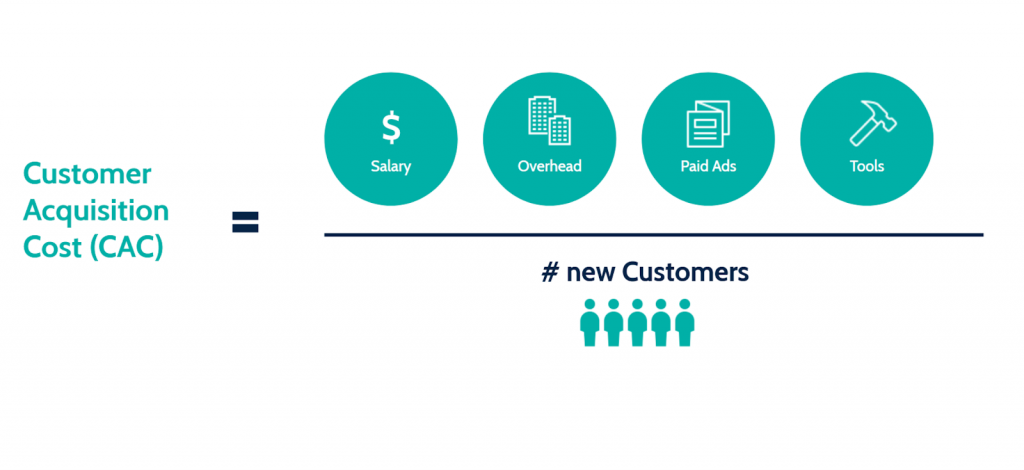
Image source: KPIMax
Keeping an eye on your overall CAC is a way to understand how well your sales and marketing efforts are paying off, and how much your customers are spending in return. In short: the value of each customer. What’s more, you can delve deeper into channel-specific CACs to see which marketing channels are reaping the most returns for your business.
Customer lifetime value (CLV) is another metric that you should be keeping an eye on as an enterprise-level organisation. If you have a high value per customer, it shows that your customers spend more once you acquire them.
In an ideal world, you should have a high CLV to a low CAC. As a rule of thumb, a ratio of 3:1 and above is solid, as it suggests that a customer spends 3x more than what you spent to get them in the door.
This number is also important when it comes to scalability. If you’re looking to branch out to new markets or grow your enterprise, a strong CLV to CAC ratio indicates a profitable business model in the long run.
So how do you decrease your CAC?
Invest in Enterprise SEO.
While most businesses jump to quick-win paid search channels, studies have shown time and again that SEO and content marketing have the lowest CAC:
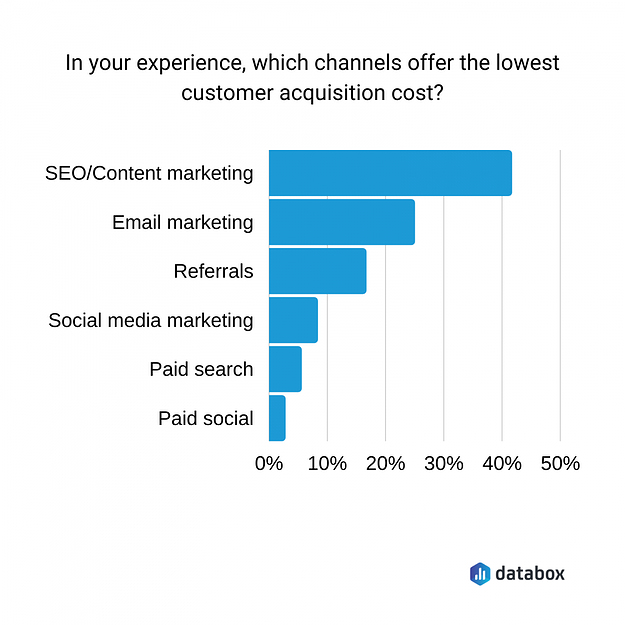
Image source: Databox
These channels also scale differently to paid avenues. Paid advertising on Google has a lower barrier to entry (i.e. budget) and you get bigger traffic wins at the beginning, but this growth tapers off over time. SEO and content marketing strategies, on the other hand, have a high barrier to entry but this pays off exponentially in the long run with more traffic to your site and more sales.
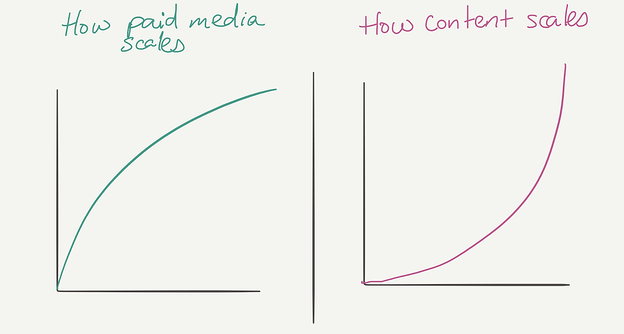
Image source: How to SaaS
Bottom line is: If you’re looking for a long term strategy to decrease CAC and improve ROI, SEO is the way to do it.
But here’s the tricky part. Enterprise SEO strategies require more time, effort and creativity than standard organic search strategies. You need a holistic and agile enterprise SEO game plan that’s tailored to YOUR specific customers and company needs. That’s why so many brands struggle to build a marketing strategy that pays off in lower CAC and higher CLV.
Common Enterprise SEO Challenges and Opportunities
Challenge: Most enterprise SEO content out there is misleading
If you’re looking for advice on enterprise SEO, the first thing you’ll probably do is run a search online. However, after sifting through swathes of content, you’ll probably find that most information out there is either:
- Generic and focused on top-level SEO strategies for Google search
- Misleading in what they claim, or how they draw conclusions from data
- Repetitive or copied from other sources
- Or not tailored specifically to enterprise-level organisations.
Unfortunately, articles like this are a dime a dozen because most SEOs don’t know what they’re doing when it comes to enterprise SEO — or they’re getting sponsored to say a specific thing.
Consider this: Even an article with “tried and tested” enterprise SEO methods for Google search may be far less accurate than you may think. Search Engine Journal reported that, for decades, SEO professionals have been testing and conducting studies that may appear legitimate, but only delve into the surface of Google’s insanely complex algorithm. These studies appear to confirm correlations between certain actions and improved rankings or organic traffic; however, they haven’t necessarily made it through the rigorous testing needed to really prove causation.
“Without knowing the details of how any of these companies create their metrics, I’m suspicious there’s a significant amount of confirmation bias occurring. The confirmation bias error shows up a lot in these SEO articles…This is common with any topic where someone’s telling you how to get an advantage.”
Jen Hood, Technical Business Analytics Consultant
What’s more, a lot of the SEO experts you’re reading content from are probably just starting out in their career. The majority (55%) of professionals in the industry have less than 5 years of experience under their belt, and 79.78% of the global demand for SEO jobs is focused on entry-level or beginners candidates. This means that while you may receive generic advice based on desktop research, the SEO professionals you’re working with may not have as much hands-on experience getting results for businesses of a similar size and scale.
This makes it INSANELY tough to know which information out there to trust, or separate the fact from the fiction when it comes to your enterprise SEO services. And without knowledge and experience from experts, you’ll end up sinking time into SEO tactics that don’t make a real difference in your CAC.
Opportunity: Each enterprise is unique. Each enterprise SEO campaign should be too.
Each enterprise SEO strategy is an opportunity.
Enterprise-level organisations are unique. Each one operates in a different way, with different products and/or services, different target audiences, and different markets. If you tailor your enterprise SEO strategy to meet the specific needs and behaviours of your audience, you’re in a good position to achieve a massive reduction in your CAC.
According to a Think with Google survey, 90% of leading digital marketing professionals say personalisation significantly contributes to organisational profitability. And while the basics of SEO remain the same regardless of the size of your organisation, the way you adapt these for your enterprise and your potential customers will make a massive difference in rankings and CAC.
This means considering the unique buying journey for different customer personas or product lines, then tailoring your keyword research to each stage. Once you understand where they’re coming from, you can begin to create tailored content that’s relevant to them at key points in the journey or to address specific search intent.
Enterprise-level organisations also typically have multiple decision-makers and more touchpoints within each stage of the buying journey, particularly for high-value products or services. Your content marketing needs to be targeted and relevant for all of these audiences if you want to build a holistic and agile strategy that truly cuts down CAC.
For example, if you’re running an enterprise-level SaaS company, you might need to convince the CFO, CEO, CMO and CTO before you can seal the deal. Each respective target audience has their own unique set of challenges and pain points — a CTO might be concerned about security, while the CFO may be concerned about value and ROI. If you research and create content for a targeted keyword list addressing each of these pain points, you’ll have a much easier time getting customers over the line.
In fact, a study by Accenture found that 91% of consumers are more likely to shop with brands who recognize, remember, and provide relevant offers and recommendations — and a massive 83% are willing to give up their data for a more personalised user experience.
Beyond tailoring your keyword research, keyword targeting and content marketing, it’s also important to adapt your enterprise SEO strategy for specific languages, markets, and different product lines. And most importantly, you need to ensure that every page on your website is technically sound and is internal linking to other pages, particularly if you have thousands of product pages or multiple brands operating under one umbrella.
It’s a lot of work, but this personalisation will pay off in spades down the road.
Challenge: Enterprise SEO strategies need to be scalable.
Enterprise SEO involves optimising hundreds or thousands of product pages for organic search results on Google. But while a number of SEO agencies claim to “do enterprise SEO”, few teams have the infrastructure and resources to support search engine optimisation on a large scale.
A truly effective enterprise SEO campaign NEEDS to be scalable. We’re talking automation, effective workflow management, and robust reporting.
With enterprise SEO, keyword research needs to happen for thousands of products, which is a mammoth task in and of itself. Throw in content creation and on-page optimisation to improve rankings, as well as link building, and you have full-time jobs for an entire mid-sized agency or in-house team. Then there’s the added task of needing to be able to detect technical SEO issues with crawlability and indexability issues across thousands or tens of thousands of pages, then resolve them quickly and without affecting other pages.
Everything needs to be bigger with enterprise-level SEO, which is why automated tools are your best friend.
More importantly, you need to have the right workflows across your organisation to do SEO on this large scale. Each individual brand, product line, country, or market needs to adhere to the same systems, use the same tools, and adopt the same best practices for enterprise SEO to truly work. Without the right digital platforms and reporting tools, it’s near impossible to identify what’s working and ensure everyone is on track across the entire company.
Then there’s the question of cost. Enterprise-level SEO tools are expensive, which makes it difficult to prove the business case for them — particularly if you don’t have an expert on the marketing team.
Opportunity: Frameworks help you applying standard ways to deal with situations that occur over and over.
Strategic and organisational frameworks are a powerful tool to help leaders analyse where and how to compete, grow, and manage an organisation as effectively as possible. These can be used to determine which products or business units to invest in with enterprise SEO, or to establish a systematic approach across teams.
There are a number of frameworks out there, but these are our favourites for SEO:
Nine-box matrix
This is a handy tool to help decentralised teams determine where to invest cash between business units, channels, or product lines. With the nine-box matrix, leaders can judge the success of a specific unit line by two factors: the attractiveness of its industry and its competitive strength within that industry.
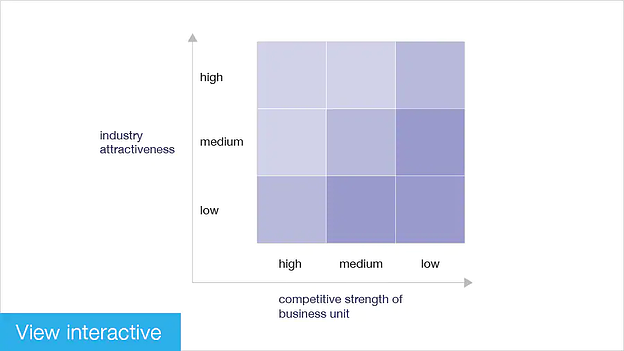
Image source: McKinsey
Units above the diagonal are opportunities for investment and growth, while those below should be deprioritised or run purely for cash.
7-S Framework
Organisational effectiveness is critical to any successful enterprise. Unlike a traditional small or medium-sized company with managers and team members, enterprises often operate on a larger scale with greater complexity in reporting lines. The 7-S framework helps leaders understand the complexity of their organisation and the role that coordination plays in the team’s success across 7 elements: strategy, structure, systems, shared values, style, staff and skills.
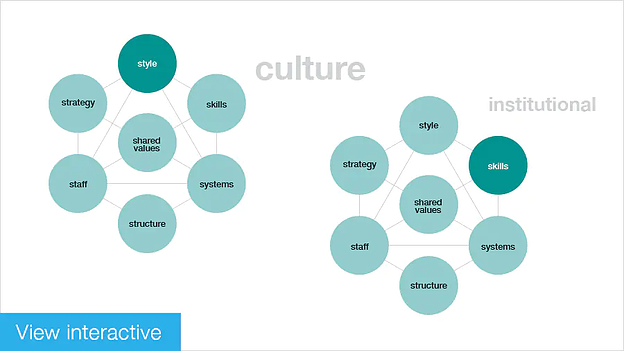
Image source: McKinsey
With the 7-S Framework, leaders can better grasp their organisation’s design and, in turn, how effectiveness can be achieved within that framework. This is critical when it comes to rolling out enterprise SEO strategies: with 7-S, you’ll be able to pinpoint your team’s strengths, identify gaps in skills, and determine how to roll out best practices and reporting systems to ensure your search engine optimisation strategy is holistic and tied to broader company goals.
The Business System
The Business System guides companies to evaluate decisions at each stage of the business process and ensure every action is contributing to a truly integrated strategy. Done well, this system helps enterprises gain a competitive edge in the market and strengthen the overarching strategy. At each link in the chain, leaders and team members need to assess how their actions are reinforcing the value proposition or the product, brand or business.
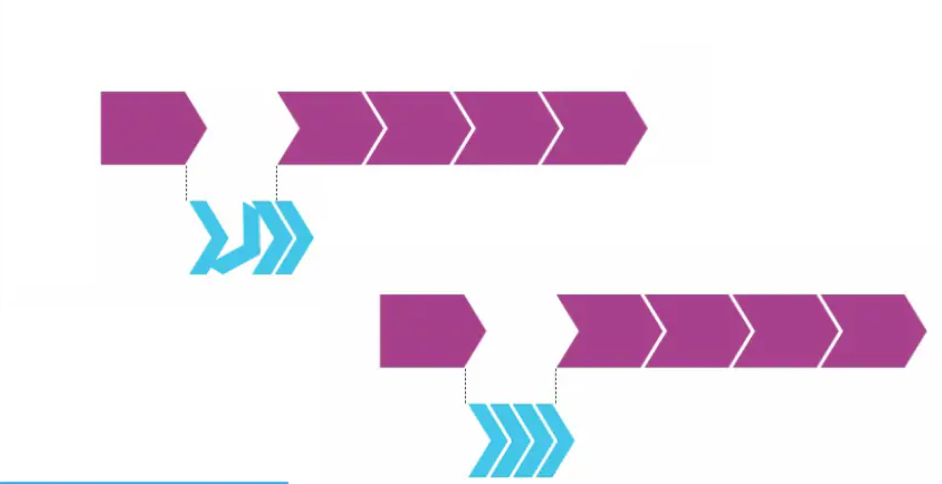
Image source: McKinsey
Although the business system is commonly used in product design and development, this process is also handy to use in digital marketing and enterprise SEO. Each link in the chain could be a different tactic or action that plays into the broader business strategy, whether that’s improving visibility, driving down CAC, or improving ROI.
Opportunity: Every PR campaign is a gold mine for links.
Small and medium-sized businesses typically struggle to generate links back to their website. Enterprises, on the other hand, often benefit from solid levels of existing brand awareness and have dedicated budgets for maximising visibility online and offline. If you tap into these, you have a gold mine of opportunities for link building and off-page SEO.
Any time you’re running a PR campaign, consider including links back to your website and incorporating target keywords that are related to your press release. Once your PR team secures a placement, request that the content link back to your website. This simple action will help you improve your brand visibility through PR and SEO at the same time PLUS drive even more organic traffic to your website.
Studies are also an incredible way to amass links back to your website at scale and improve your SEO rank. As an enterprise, you most likely have a ton of data you can draw on for surveys, industry reports, and white papers. These are a gold mine for links: for example, Backlinko created one study analysing SEO tools for keyword research, link building, internal linking, featured snippets, voice search, and more. This single page generated a massive 13,500 links back to their website:
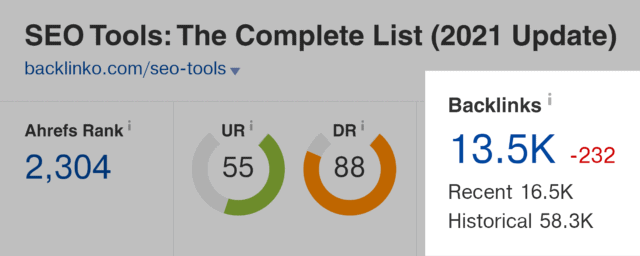
At the same time, use a tool like Ahrefs to scour the web for any legacy pieces of coverage that don’t have links back to your business. This low hanging fruit will give a much-needed boost to your domain authority and website traffic without too much extra time or investment.
Challenge (and opportunity): Leveraging enterprise local SEO.
Any enterprise operating in multiple markets or locations needs to have a presence in local search results. According to Wordstream, 28% of local mobile searches result in a purchase, whether it’s done through voice search or by typing into the search bar. This makes the conversion rate of local Google searches almost 7x higher than Google Ads – which means any marketer looking to decrease CAC can’t afford to overlook local SEO.
However, many enterprise-level companies lack the coordination needed to help individual franchisees, shopfronts, or branches flourish in local search. Content Marketing Institute found over half of all enterprise organisations say integrating marketing efforts across their organisation is one of their top three challenges.
If you want your individual stores to perform well in search engines, you need to have the right local SEO enterprise tools. Platforms like Yext, BrightLocal and RioSEO are great at helping store managers and marketers optimise their listings on Google My Business and other platforms, while allowing higher-level executives to get an overview of how local SEO are tracking.
Skills are also crucial here: even the best local SEO enterprise tools won’t help a team if they don’t know how to use them. Dedicated training courses on SEO can bridge some of the digital marketing skills gaps within your team – or if you’re looking to improve your online presence in local search results ASAP, an external agency can complement your team’s existing skills and fill in the gaps.
Opportunity: Leverage content atomisation to 10x content output.
As we touched on earlier, every part of your enterprise SEO strategy needs to scale – including your content marketing. However, unlike other processes, quality content creation can’t be automated. It takes considerable time and thought to produce high-quality content that ranks for your target keyword, particularly if it’s a highly competitive keyword.
Rather than churning out hundreds of pieces of unique content, you can instantly 10x your content production with content atomisation.
Say you’re a B2B marketing automation company serving multiple industries, and you’ve created a white paper on effective customer relationship management. You may be looking to rank for keywords related to CRM in retail, tech, hospitality and FMCG, and need to create fresh pieces of content to help you do so.
Rather than produce individual content from scratch, you can take the bulk of your inbound marketing white paper and adapt it into separate pages of content that are geared to help you rank for each respective industry. By using one piece of long form content and customising the last 25% to make it relevant to the specific keywords you’re trying to rank for.
The same goes for any other content you create in the future. If you shoot videos or host webinars for lead generation, consider transcribing them and turning them into blog posts or landing pages. If you’re writing a blog post, turn it into an infographic for Google Image Search or share it across multiple markets to adapt themselves. And, likewise, if you’re developing a white paper for your website pages, look for opportunities to leverage this in a guest post across other industry publications.
With content atomisation strategies, you can scale your output dramatically without needing to scale your website resourcing.
Turn enterprise SEO challenges into opportunities
Your company and website are one-of-a-kind, which means your enterprise SEO strategy needs to be as well. When you’re aware of the challenges and opportunities that come with enterprise SEO, you’ll be in a better position to rise up through the rankings in search results – regardless of how big your company is or how complex your website may be.
Unlike most agencies out there, we know every enterprise needs a tailored strategy to reach the first page of Google results and, more importantly, to stay there. That’s why every SEO strategy we craft is painstakingly developed for your enterprise website and made to align with your unique company goals. From content creation to long tail keyword research, voice search, featured snippets, technical SEO and external/internal linking, we’ll engineer a holistic game plan that’s geared to get you on top.
Ready to get started? Get in touch with us today and find out how we can help you increase organic search engine traffic and decrease CAC with an enterprise SEO strategy.









